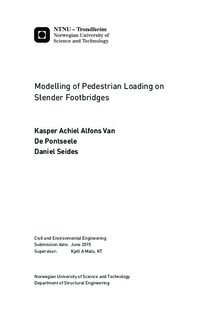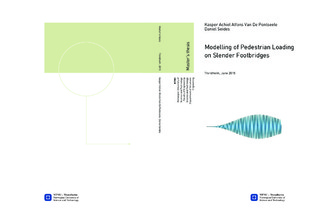| dc.description.abstract | This thesis concerns itself with the dynamic response of a slender network arch bridge by means of a numerical model. The numerical model is generated using a Python code written by Ph.D. Candidate Anna Ostrycharczyk. The code was modified by the authors to include pedestrian loading. Based on a modal analysis of the bridge, the first ten natural frequencies and corresponding mode shapes were extracted, and attempts at exciting each mode by simulating pedestrian loading were carried out.
The acceleration of the bridge deck was the main variable of study, as this is what pedestrians feel and react to while walking across the bridge. The accelerations achieved through numerical analyses have been compared to the suggested values in design guidelines, both to check if the design guidelines have valid methods for calculating accelerations and to check if the bridge in study fulfils the guideline criteria.
For single pedestrian analyses the dynamic response matched the design guidelines' predicted response fairly well, and were within the presented criteria. Simulating groups of pedestrians yielded extremely high acceleration responses. They were considered worst case, but not very realistic. Other load cases such as running were also simulated.
The specific acceleration values retrieved in this thesis are not useful, because the dimensions of the bridge in study are still subject to change. However, three modes were found critical for the bridge. One mode was concerned with the lateral responses of the arches and the two others with the lateral and vertical responses of the deck. It is fair to assume that similar modes will dominate the response of any slender network arch bridge. These mode shapes should be studied carefully and will be governing in the placement of any external dampers.
The methods for calculating vertical accelerations in the guidelines are often too simple. This should be addressed as more slender footbridges with unique designs are being built every year. The way horizontal accelerations are covered is also deficient. The guidelines propose methods dependent on frequency ranges, disregarding the fact that higher harmonics of the walking frequency might excite the bridge. Horizontal resonance was achieved in this study, despite the fact that most guidelines deemed it unnecessary to check.
The numerical method used in this thesis shows promise, but needs to be developed further, especially for simulating groups of people. The material damping implemented in the numerical model proved the importance of damping, especially at resonance. Through further work a method may be obtained to calculate the dynamic response of a footbridge for a given amount of damping. This way the minimum amount of damping necessary to satisfy the comfort criteria stated in design guidelines can be found. | |

